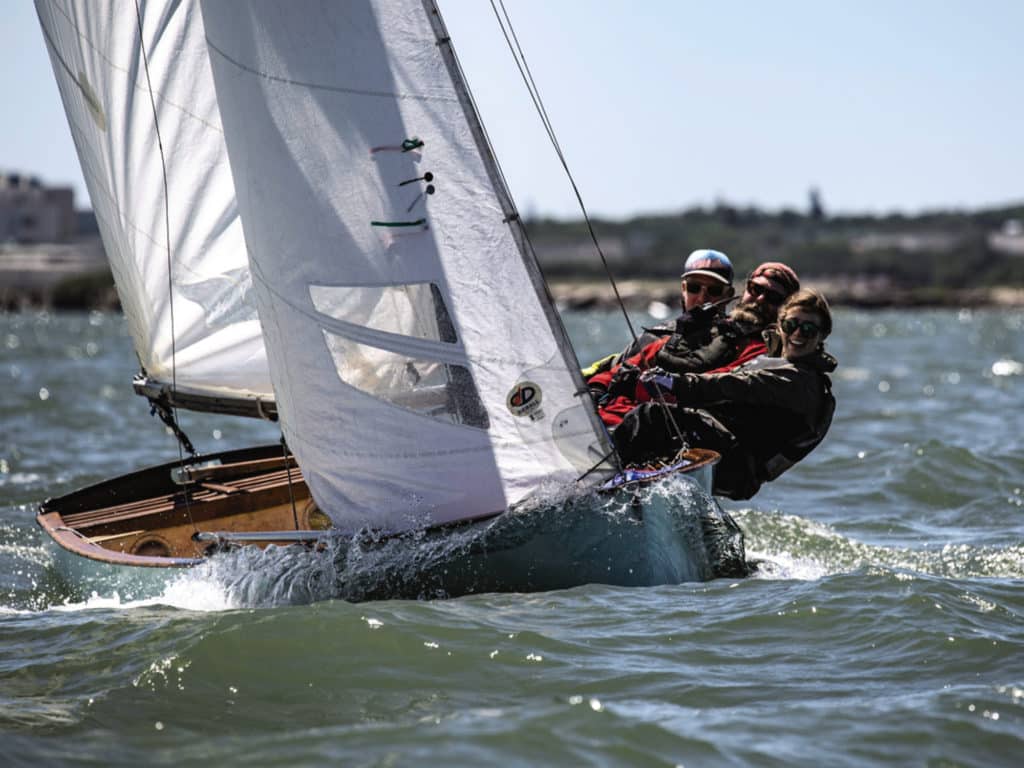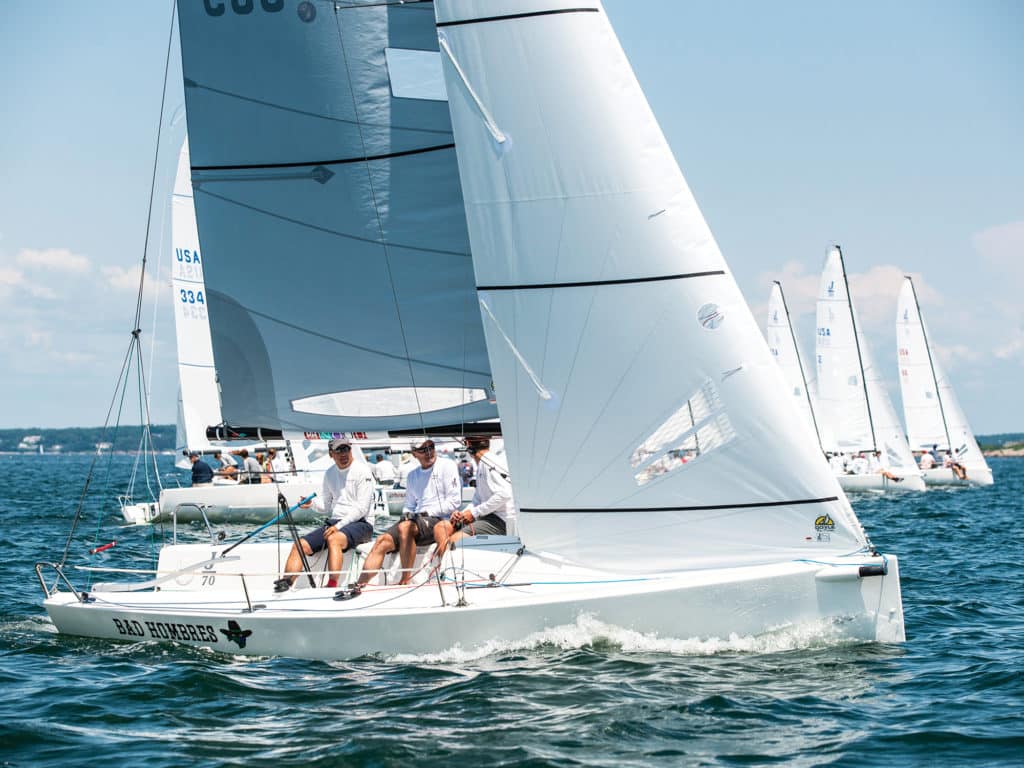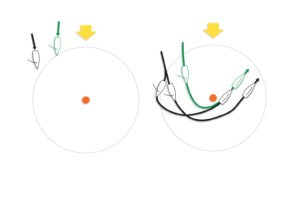
It’s good to have rules of thumb to help you sail the boat as fast as possible in all conditions. Such guidelines can help the skipper drive their best and give the crew a common purpose in how they react to changes in wind. One distinction that can help you increase speed is to identify if you should be telltale or heel-angle sailing. In lighter winds, telltale sailing is appropriate—the skipper works hard to stream the telltales at all times for maximum speed, and the crew moves around to create perfect heel. In overpowered heel-angle sailing conditions, the skipper can steer much more freely, focusing on a consistent heel angle while the crew hikes hard. In light air, it’s all about maintaining speed; in breeze, it’s all about the heel angle.
Underpowered Conditions
Here, the crew controls heel angle and the skipper sails exclusively to the telltales. The goal is to stream the telltales, setting up the boat for maximum speed. The heel angle is totally on the crew, and it’s best if someone can communicate the power in the boat—maybe the skipper or mainsheet trimmer—to help coordinate the team’s movements. If it’s really light, you might be heeling the boat a little extra to leeward, and just how much needs to be communicated to the crew so the boat feels as good as possible.
In these light conditions, the jib trimmer should be to leeward playing the jib. If shifts come or the skipper needs to sail deeper to gain speed, the jib trimmer is right there to trim or ease, depending on the situation. The main goals the skipper is trying to achieve are sailing straight and keeping max speed. To allow that to happen, the crew moves to keep the heel angle perfect while the jib trimmer adjusts the jib.
For example, if there’s a wave set coming, the jib trimmer eases the jib while you bear off slightly. The bow down and coinciding jib ease keep the telltales streaming. The same thing happens if the boat suddenly slows—bow down and jib out to keep the telltales streaming. If the boat starts to feel great and the skipper can head up, the jib trimmer trims the jib with the turn to keep the telltales streaming perfectly.
Going straight, as opposed to heading up in a puff, or bearing off to pick up speed really connects the wind to the jib. Ideally, it never stalls. Some people call it “pressing” or “sailing fat” on the jib. Either way, you’re creating power, and that’s where the boat feels best. If the leeward telltales start to luff, the jib trimmer eases the jib a little to make the telltales stream rather than having you heading up. If you head up for heel-angle sailing in light winds, you end up pinching, and it really slows the boat. In a small puff, it’s much faster if the crew hikes against that power while you continue to sail straight.
During this light-air mode, the crew should be fully focused on moving around to keep the boat at the desired heel. When a puff hits, they should move to the high side quickly and smoothly to keep the heel perfect, and when the breeze dies, they should slide in. A slow-moving crew encourages the skipper to head up in puffs and bear away in lulls, which wastes power in puffs and height in lulls, and reduces speed. A well-coordinated team in light air is very fast—skipper sailing fast, jib trimmer working the jib, and crew super-concentrated on the perfect heel. Because it’s fast to have the jib trimmer play in the jib in lighter winds, the first person off the rail in a dying breeze should be the jib trimmer. They are much more effective to leeward, with a perfect view of the jib.
Building Breeze
Now the crew is starting to get up on the rail. They’re not yet fully hiking, but everyone’s on the high side. You trim the sails in a bit, the jib trimmer is on the high side, and the jib is cleated. The boat’s feeling pretty good. Now you can start sailing a little more to heel angle, which means steering up a bit in the puffs. The main trimmer is in the loop here as well, helping the skipper keep the boat at the correct angle of heel.
Keep in mind that, if there’s chop or waves, the boat is reaccelerating all the time, so you might not be able to pinch so much in the puffs in these conditions. You might be telltale sailing still if it’s real bumpy, so when you get a puff, the crew should hike and trimmers should ease the main or depower in some other way, depending on your boat—traveler down, backstay off, whatever you’re playing to keep the boat on its feet and keep speed through the chop.
In flat water, it’s fine to head up in the puffs a little to keep the heel angle down, raising the forward inside jib telltales to 45 degrees or so. As a rule, head up just enough for a little telltale lift when needed and encourage the crew to hike hard. Briefly pinching buys you time to depower and get the crew hiking, all the while keeping the heel angle perfect.
Overpowered Conditions
This is true heel-angle sailing. The breeze has built to the point where everyone’s fully hiked, and you’re easing the main or dropping the traveler to keep a constant angle of heel. The crew has essentially become ballast, and they are hiking as hard as they can. As long as the boat’s moving at a decent speed, you can head up as much as you need to keep the boat flat. In a big breeze, you might even luff a foot or two of the front of the jib when a big puff hits until you get sorted with easing the main, tightening the backstay or whatever you’re doing to depower. You’re going so fast and having so much power (too much) that sailing that high is fine.
A few years ago, when I was sailing my Etchells—just my third regatta after buying it—the breeze quickly increased, and we were overpowered. I headed up to keep the boat from heeling too much, bubbling the front 6 inches of the jib, and my main trimmer said, “Awesome mode! We’re flying!” And I was thinking, “What? I’m waiting for you guys to depower the boat so I can put the bow back down.” But I looked around, and we were higher and faster than everybody. We experimented with flattening the main and getting the bow down to stream the telltales, but it was not quite as good. That day we learned a new mode—that we could luff the jib in breeze and we’d go just fine. The main point here, though, is that in heel-angle sailing, the skipper should steer up to avoid heeling.

If it’s breezy but the water is flat, you can pinch a little more because there are no waves to slow the boat. If you’re sailing in waves and pressing on the telltales to go faster, constantly trying to accelerate, watch for flat spots. Every surfer will tell you that waves come in sets and in different shapes and sizes. Even on wavy and choppy days, there will be 5- to 15-meter circular spots that are pretty flat. Some sailors call them plateaus. If you enter a plateau and get a puff, try to feather or pinch. In general, you’ll probably be able to sail little higher than when in the bumps. Just before the waves return, drop the bow down, depower, and go for speed. In those conditions, you’re shifting back and forth between slightly bow down and true heel-angle sailing based on waves or flat spots.
The art of driving well comes after you understand everything we’ve been talking about, but then throw in the presence of shifts. Steering well suddenly becomes a moving target as you try to keep the boat at the perfect angle to the wind and coinciding perfect heel while the wind is shifting.
When that’s the case, here’s a good rule of thumb: If a puff is approaching from directly in front of you, it will most likely be a header. If it’s coming from your windward side over your shoulder, it’s most likely a lift. Knowing this can help you drive and trim the sails more accurately when they hit. The goals—maintaining a constant angle of heel and good speed—are the same, and if you can follow the shifts up and down while accomplishing that, you can really sail away from the fleet. For example, you get a nice-size puff that overpowers the boat. Normally during heel-angle sailing, you would head up to keep the heel the same. But if the puff is a header, you continue steering straight, the front of the jib bubbles, and everything works out fine. The shift helped you pinch without having to steer.
Conversely, again in a big breeze, you get a big puff, and it’s a lift. You understand that in overpowered conditions, a puff that’s also a lift is really going to knock you over. That’s because all of the sudden you are tight reaching, the opposite of pinching. It’s as if you bore away in a big puff, causing the boat to heel more. Rather than getting knocked over, good teams will “burp” the sails an extra amount right from the start, and the skipper will start heading up quickly and steer more than normal. That will help avoid the excess heel angle. At that moment, the main trimmer must ease the main a lot, and if the jib trimmer can ease the jib as well, or maybe the inhauler, even better.
On a J/70, for example, the jib trimmer might be inhauling the jib by bow-stringing the windward sheet on the high side, pulling the clew toward the mast. In that lift and puff, easing the windward sheet moves the jib trim-angle outboard, similar to easing the leeward sheet but better because the jib does not increase camber. It’s like dropping the main traveler—the whole sail barn-doors out while keeping the same shape and depowering the boat, and also opening the slot between the main and jib. Once back to a pinching angle, retrim the sails, and off you go having avoided excess heel.
In a blustery breeze, you can make big gains by balancing the concepts of sailing by the telltales and sailing by heel angle, knowing what your desired angle to the wind is and then factoring in lifts and headers along the way. The goal is to keep your boat in the best state possible, knowing that you’ll never be perfect all the time. As a skipper, when I head out for a race in shifty conditions, I think: “I’m going to try to keep my boat and sails at the perfect angle to the wind more than everyone else. And if I can do that a higher percentage of the time, I’ll probably be the fastest boat out there.” Keep in mind the two steering modes, and you can too.









